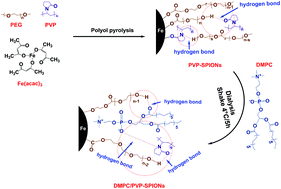1,2-Dimyristoyl-sn-glycero-3-phosphocholine promotes the adhesion of nanoparticles to bio-membranes and transport in rat brain†
Abstract
1,2-Dimyristoyl-sn-glycero-3-phosphocholine (DMPC) coated on the surface of superparamagnetic iron oxide nanoparticles (SPIONs) has advantages in neurotherapy and drug delivery. In this study, the surface of polyvinylpyrrolidone (PVP)-SPIONs was modified with DMPC, then PVP-SPIONs and DMPC/PVP-SPIONs were co-incubated with rat adrenal pheochromocytoma (PC-12) cells to observe the effect of DMPC on the distribution of SPIONs in cells, and further PVP-SPIONs and DMPC/PVP-SPIONs were implanted into the substantia nigra of Sprague-Dawley (SD) rats by stereotaxic injection, and the brain tissues were removed at both twenty-four hours and seven days after injection. The distribution and transport of nanoparticles in the substantia nigra in vivo were explored in these different time periods. The results show that DMPC/PVP-SPIONs were effectively distributed on the membranes of axons, as well as dendritic and myelin sheaths. The attachment of nanoparticles to bio-membranes in the brain could result from similar phospholipid structures of DMPC and the membranes. In addition, DMPC/PVP-SPIONs were transported in the brain faster than those without DMPC. In vitro experiments found that DMPC/PVP-SPIONs enter cells more easily. These characteristics of iron oxide nanoparticles that are modified by phospholipids lead to potential applications in drug delivery or activating neuron membrane channels.



 Please wait while we load your content...
Please wait while we load your content...